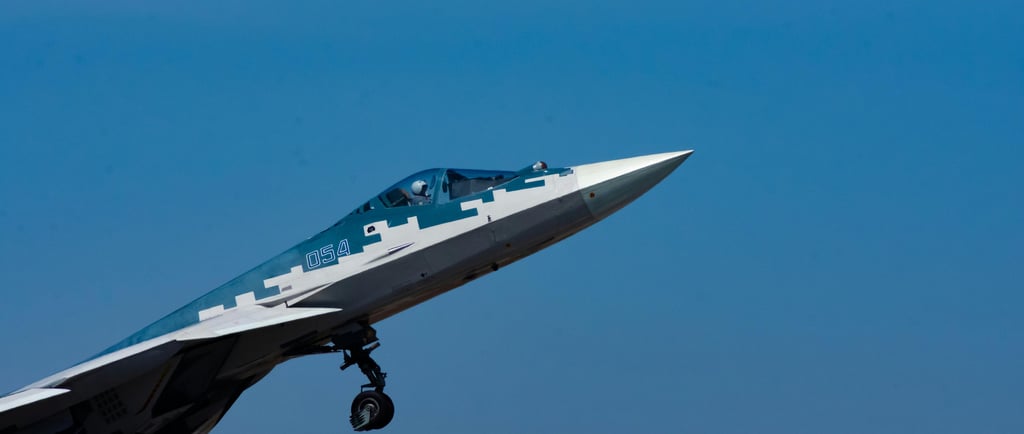Russia’s Su-57 Felon Jets Escalate Ukraine Conflict: A New Threat to NATO?
NEWS
8/7/20253 min read


Russia’s ongoing war in Ukraine has taken a dangerous turn with the deployment of its advanced fifth-generation Su-57 Felon fighter jets, intensifying strikes on Kyiv’s frontline. As reported by Polish media outlet Interia, citing Ukrainian defense officials, Moscow’s increased use of these stealth jets signals a significant escalation in the conflict, raising concerns about potential spillover into NATO territory. This article explores the implications of Russia’s Su-57 operations, their advanced capabilities, and the growing risks for Ukraine and its allies in 2025.
The Rise of the Su-57 Felon in Ukraine
The Su-57 Felon, Russia’s most advanced fighter jet, has shifted from occasional sorties to coordinated strike formations, demonstrating Moscow’s growing confidence in its stealth technology. According to Ukrainian defense officials, these jets are now a central part of Russia’s offensive strategy, targeting key frontline positions in regions like Sumy, Kharkiv, Donetsk, and Zaporizhzhia. The Russian Defense Ministry’s August 6, 2025, bulletin claimed significant battlefield gains, suggesting the Su-57 is being combat-tested for broader deployment.
Why the Su-57 Matters
Unlike older Soviet-era jets, the Su-57 is a fifth-generation stealth fighter designed to evade radar detection. Its integration into daily operations marks a shift in Russia’s air strategy, moving from sporadic to sustained assaults. This escalation has alarmed Ukraine and its NATO allies, particularly Poland, which shares a border with Ukraine and has faced repeated Russian aerial incursions.
Advanced Capabilities of the Su-57
The Su-57’s advanced features make it a formidable threat:
Stealth Technology: Its low radar cross-section makes it difficult for Ukrainian air defenses to detect and intercept.
AI-Driven Systems: Equipped with artificial intelligence-enabled “second pilots,” the Su-57 enhances precision and decision-making in combat.
Advanced Weaponry: The jets are reportedly armed with Kh-69 maneuvering cruise missiles and may soon deploy hypersonic Kinzhal missiles, previously used by MiG-31K interceptors. These weapons combine long-range precision with high speed, challenging even the most advanced air defense systems.
Ukrainian officials warn that the combination of stealth, AI, and hypersonic capabilities makes the Su-57 nearly impossible to counter effectively, posing a significant challenge to Kyiv’s air defenses.
Poland and NATO on High Alert
Poland, a key NATO member, has responded to Russia’s intensified air operations by scrambling its fighter jets and placing its air defense network on high alert. The proximity of Russian Su-57 operations to Poland’s border has raised fears of a spillover, with Warsaw warning that the jets’ growing role could threaten NATO’s eastern flank. This concern is heightened by the ongoing clashes in Ukraine’s frontline regions, where Russia’s air superiority is becoming more pronounced.
Spillover Risks for NATO
The deployment of Su-57 jets near NATO borders increases the risk of miscalculation or unintended escalation. A single misstep, such as a Russian jet straying into Polish airspace, could trigger a broader conflict involving NATO forces. Poland’s proactive measures, including frequent jet scrambles, underscore the growing tension in the region.
Russia’s Strategic Goals
Russia’s increased reliance on the Su-57 suggests a strategic shift toward testing and refining its next-generation strike capabilities. The jets’ deployment in Ukraine serves as a real-world proving ground, allowing Moscow to assess their performance against modern air defenses. The Russian Defense Ministry’s claims of territorial gains in multiple Ukrainian regions indicate that the Su-57 is being integrated into a broader offensive rhythm, potentially reshaping the conflict’s trajectory.
Global Implications
The Su-57’s combat testing in Ukraine could have far-reaching implications for global security. If Russia successfully refines its stealth and hypersonic capabilities, it may seek to export these technologies or deploy them in other theaters, challenging NATO and other Western-aligned forces. The growing sophistication of Russia’s air operations also raises questions about the effectiveness of current Western air defense systems.
What’s Next for Ukraine and NATO?
As Russia escalates its use of the Su-57, Ukraine faces mounting pressure to bolster its air defenses. International support, including advanced anti-aircraft systems from NATO allies, will be critical to countering this threat. For NATO, the challenge lies in balancing deterrence with the risk of escalation, particularly as Russian jets operate closer to alliance borders.
How to Stay Informed
The situation in Ukraine is evolving rapidly, with the Su-57’s deployment marking a new phase in the conflict. Stay updated with reliable sources like Times Now World for comprehensive coverage of global events, including the Russia-Ukraine war and NATO developments. Engaging with primary sources and expert analyses can help you understand the broader implications of this escalation.
Conclusion
The deployment of Russia’s Su-57 Felon jets in Ukraine represents a dangerous escalation, with advanced stealth, AI, and hypersonic capabilities challenging Kyiv’s defenses and raising concerns for NATO. As Poland and other allies heighten their vigilance, the risk of spillover into NATO territory grows, underscoring the need for robust defense strategies and international cooperation. The Su-57’s role in Ukraine is not just a tactical shift but a signal of Russia’s ambitions to dominate the skies in future conflicts.
